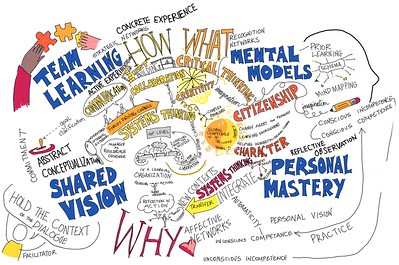
Marilou Polymeropoulou, University of Oxford, School of Anthropology and Museum Ethnography
Active learning is a well-established pedagogical strategy in secondary and tertiary education where independent learning and critical thinking are nurtured. Learners’ engagement, active participation, and reflection are situated at the core of active learning. Previous studies have shown that this strategy has been successful at reducing failure rates in STEM courses at university (Talbert et al., 2019) and at raising learner satisfaction as they enjoy their courses more (Lumpkin et al., 2015). In addition to these benefits, active learning methods can enhance learners’ experience in classes of mixed ability and knowledge.
I first trialed active learning strategies while teaching at the University of Oxford, where one of the challenges of teaching anthropology is the diverse background of the students (Bastide, 2012). Anthropology modules appear in programs in three programs I have taught: Archaeology and Anthropology, Human Sciences, and Music. The first two programs are interdisciplinary by nature, and the latter offers a diversity of compulsory and optional courses to undergraduate students, such as ethnomusicology and anthropology of music. Research in teaching anthropology suggests that students learn and understand the subject better by being involved (Copeland and Dengah, 2016) and applying the knowledge both in theoretical and in real-world situations. With this in mind and utilizing active learning as the pedagogical vessel, I created active learning classrooms placing the learner at the center of teaching, learning and assessment.
Fostering an active learning environment in undergraduate tutorials and small classes (Bierema, 2020) and giving guided instruction, allows learners to interact with each other to discover ideas and solve challenges. In this setting, group inquiry – a process whereby students engage in reflective practice about the learned concepts and ideas they study – enhances students’ learning experience by urging them to connect new to pre-existing knowledge. This process acts both as retrieval practice, helping them recall and apply previously studied concepts, and as new knowledge acquisition.

To illustrate this, in one of my tutorials on ‘Society, culture and environment’ I guided a group of four first-year Human Sciences students to reflect on their previous knowledge of Mauss’ theory about gift-giving practices taught in the module ‘Sociology and Demography’ to develop an understanding of exchange, and more specifically, Sahlin’s theory of reciprocity. Following this, I asked students to apply both Mauss’ and Sahlin’s theories to a real-life situation they have encountered. The discussion revolved around birthdays and gift-giving as an obligation between friends, and the expectation to return gifts to a friend who has already given them a present. This reflection on their academic and personal knowledge allowed them to explore in depth the concepts of positive, negative, and balanced reciprocity. This seemed to be a memorable active learning exercise for them as at the end of our tutorials they gave me a cake with ‘positive reciprocity’ written on it, embedding Sahlins’ concept, to ‘balance the exchange’: teaching was my offering in this exchange and cake was theirs!
In a second instance, while co-teaching ‘Digital Methods’ to a group of postgraduate anthropologists, me and my co-convenor Dr William Kelly introduced the use of a workshop to promote active and collective learning. Workshops allow students to work together to construct knowledge collectively (Will, 1997). The learning objective in the week we planned the workshop for was to develop knowledge and understanding of data management issues in digital ethnography. After a brief lecture that overviewed potential data management issues in digital ethnography, we introduced a table-top exercise in groups of 4-5 students, during which students had to identify data management challenges in their research projects, peer-solve them within their groups, and finally, report to the classroom their solutions and findings. Students successfully applied their knowledge and skillset to their peers’ projects, thus solving data management problems while offering a different perspective and/or teaching their skills to others.

One additional benefit of the workshop model was that differentiation was more targeted in small groups: both me and my co-convenor circulated amongst groups to facilitate the activity while identifying any students who needed further support, addressing any knowledge gaps and answering students’ questions to clarify their understanding. This allowed us to incorporate differentiated instruction in the classroom catering to the learners’ needs. Workshops were also embraced by students who were participating in the class remotely, using breakout rooms on MS Teams. To evaluate the effectiveness of the workshop as an active learning method, we utilised the ‘keep/add/discard’ evaluation approach. Feedback was positive and students expressed workshops are particularly useful as they have the opportunity to examine their research project from various viewpoints and learn from their peers.
References
Bastide, H. (2012). Three challenges in teaching anthropology. Teaching Anthropology 1(2), pp. 56-67.
Bierema, L. L. (2020). Incorporating active learning into your educational repertoire. In M. Fedeli, & L. L. Bierema (Eds.). Connecting adult learning and knowledge management: Strategies for learning and change in higher education and organizations, pp. 27-50. New York, NY: Springer.
Copeland T., & Dengah, F. (2016). “Involve me and I learn”: Teaching and applying anthropology. Annals of Anthropological Practice 40 (2).
Lumpkin, A. & Achen, R. & Dodd, R. (2015). Student perceptions of active learning. College Student Journal. 49, pp. 121-133.
Talbert, R., & Mor-Avi, A. (2019). A space for learning: An analysis of research on active learning spaces. Heliyon 5(12).

Leave a Reply
You must be logged in to post a comment.